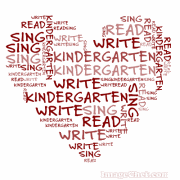Math stations are moving along...we're still working on things like noise level and cooperating with our partners, however the students are independent enough now that I don't need to be constantly monitoring the stations. This has been particularly nice this week since I have been able to use my math station time to pull students for some of the endless report card testing that needs to be done one-on-one.
This week the math games were a bit of a hodge podge of all our October themes (bats, fire safety, pumpkins). We are currently working on numbers 1-10 in our math book, and our math stations this week focused heavily on number recognition and counting skills.
Station 1: Boo Game
(This game is from
Mrs. Wills' Halloween Math Work Stations Pack. Students roll the dice and cover up the ghost on the game board with that number. Mrs. Wills also offers a more challenging game board with bigger numbers to help differentiate this activity.)
Station 2: Halloween Counting
(This free game is from
Kelly's Kindergarten. Students pick a game card, count how many pumpkins are on the card, and then cover up that number on the game board's gate. The students had such fun folding up the paper to cover the gate on this game. Kelly also offers a fall version of this game board-which is a good option if you can't use a game board with witches on it.)
Station 3: Spooky Numbers
(This game is from
Mrs. Wills' Halloween Math Work Stations Pack. My kids never tire of this game. You roll a dice and then trace the corresponding number on the game board. Somehow just the name "spooky numbers" and the clipart of "spooky eyes" at the top of the sheet made this game seem completely new to my students even though they play some variation on this game every week! Mrs. Wills also includes a more challenging recording sheet with larger numbers where students can roll two dice. )
Station 4: Firedog Math
(One of my teammates created this game long before we were all using computers to design math stations! I love how simple it is, you just roll the dice and color in a square with the number you rolled. The kids liked seeing which firedog would win by getting the number above him rolled the most.)
Station 5: Number Matching Game
(This game is from
Julie Lee's October Small Group Intervention Pack. Students counted the objects on the picture cards and then matched the picture card to the corresponding number card and number word (the number words provided a nice challenge to really get my students thinking!)
Station 5-part 2: Pumpkin Seed Counting
(Since the number matching game above doesn't take that long, I also included this simple game in Station 5. Students counted how many pumpkin seeds each pumpkin card had and then matched it to the corresponding number card. This game could easily be made by drawing seeds onto pumpkin die-cuts.)
Station 6: Candy Corn Count
Station 7: Pumpkin Counting
(This was probably the most exciting station for my kinders this week. I bought the little pumpkin containers a few years ago (possibly at Target?) and wrote a number on the back of each one. Students can practice lining the pumpkin containers up in number order and then they count out the right number of pumpkin erasers to put into each little basket.)
Station 8: Batty Ten Frames
Station 9: Polka-Dot Pumpkins
Halloween Eraser Patterns
(This was not actually one of our math stations this week. However, yesterday I had a student that was causing some trouble during math stations time and needed a little time out from her station and a little time away from her partner! After a few minutes though, I figured I didn't really want her just sitting in time out wasting her precious math time, so I had her practice making patterns with these mini erasers. I am finding so many great uses for these little erasers that I will have to do a separate post on them!)
I'd love to hear how your math stations have been going this month!










